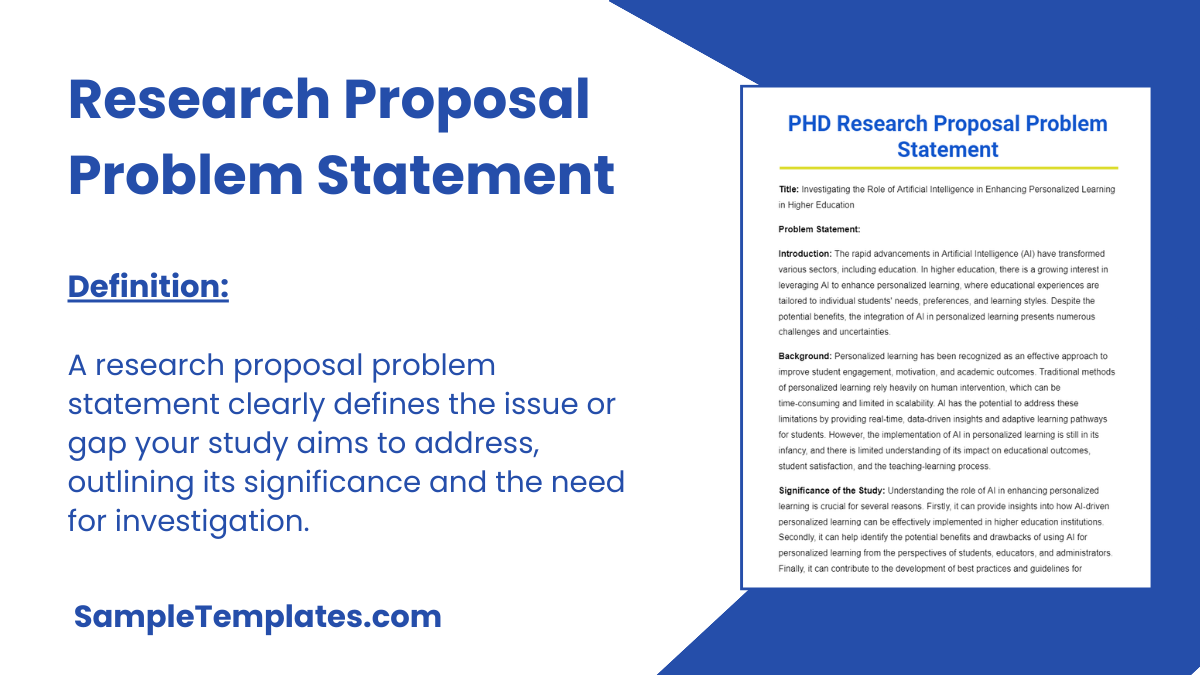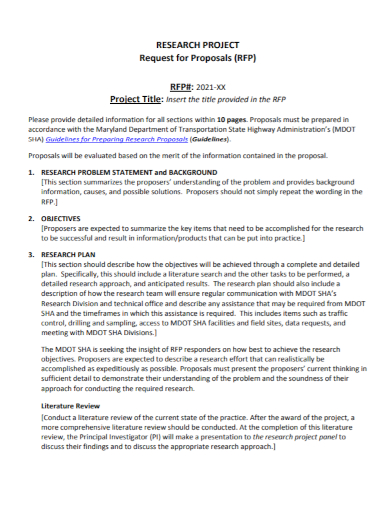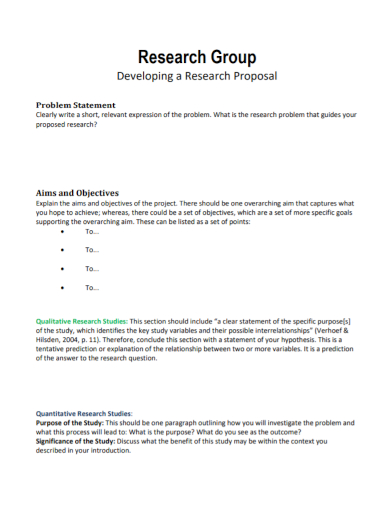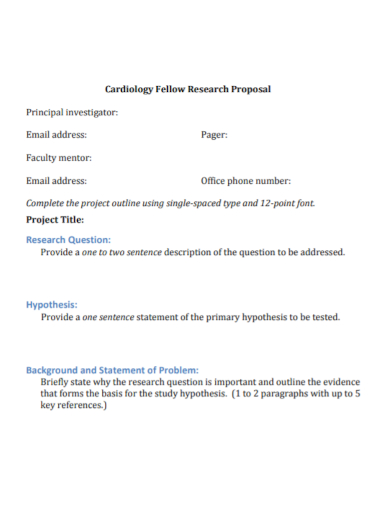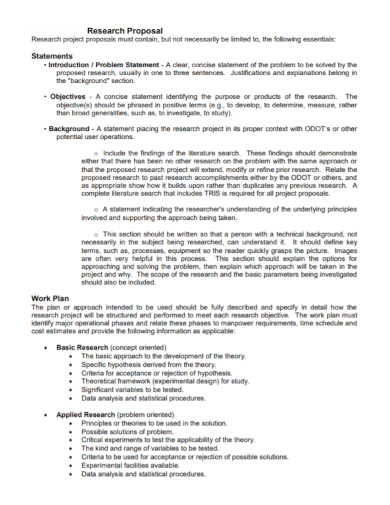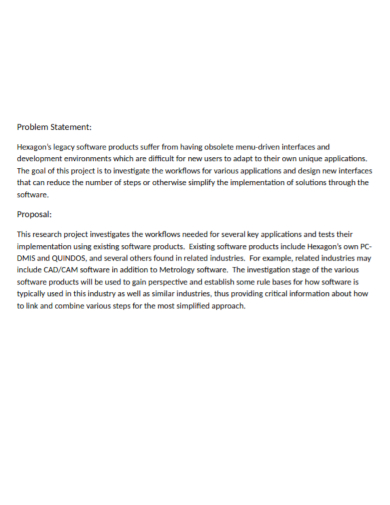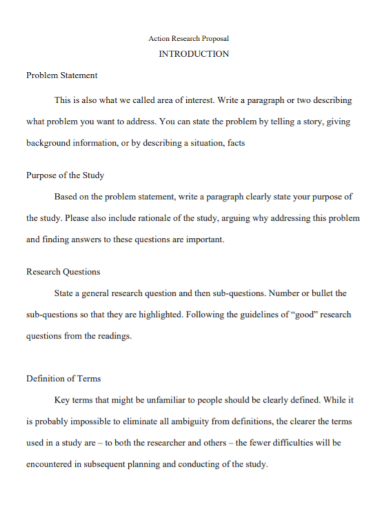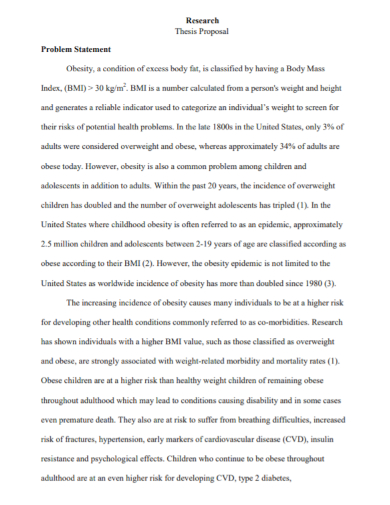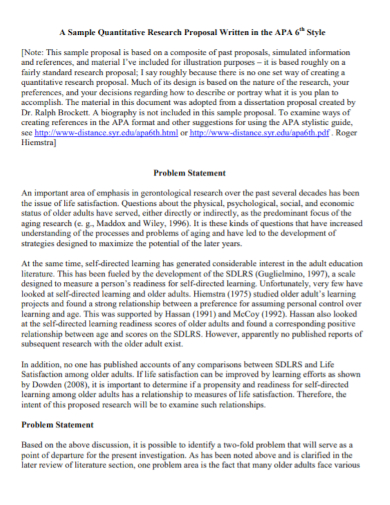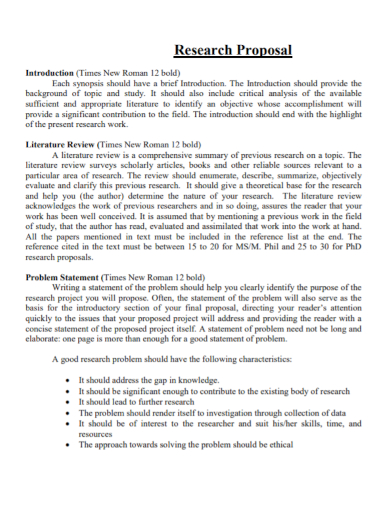Are you in the midst of starting a research paper? Finding the correct related literature and data for your paper is challenging, but creating your research problem is one of the crucial section of any sample paper as this defines the direction of your research. By discovering new facts, research is a methodical investigative procedure used to expand or revise present body of knowledge. Basic research, which is inquiry intended at growing scientific knowledge, and applied research, which is effort directed at leveraging basic research to solve problems or develop new processes, products, or procedures, are the two broad types. In this article, we provide you with free and ready-made samples of Research Proposal Problem Statements to lighten your workload for your future research proposal paper. Keep on reading to find out more!

Download Research Proposal Problem Statement Bundle
Statement of the Problem Qualitative Research
Title: Exploring the Experiences of First-Generation College Students in Navigating Higher Education
Introduction: First-generation college students—those whose parents have not earned a college degree—face unique challenges in navigating higher education. Despite various support systems, many of these students struggle with academic, social, and financial obstacles that can impede their success. Understanding their experiences is crucial to developing more effective support mechanisms.
Problem Statement: While the number of first-generation college students continues to grow, there is limited qualitative research that delves deeply into their lived experiences and the specific challenges they encounter. Quantitative data provide an overview of their academic performance and retention rates, but fail to capture the nuanced, personal experiences of these students.
Significance of the Study: This study aims to fill the gap in literature by providing a comprehensive understanding of the lived experiences of first-generation college students. By exploring their stories, this research seeks to uncover the personal, social, and institutional factors that affect their academic journeys. Insights gained from this study can inform policies and practices in higher education institutions, ultimately contributing to improved support services and success rates for first-generation students.
Research Questions:
- What are the personal and academic challenges faced by first-generation college students?
- How do first-generation college students perceive and utilize available support services?
- What coping strategies do first-generation college students employ to overcome obstacles in their academic journey?
Conclusion: By exploring these questions, the study aims to provide a deeper understanding of the experiences of first-generation college students. The findings can help educators, policymakers, and support staff create more effective interventions that address the unique needs of this population, fostering a more inclusive and supportive educational environment.
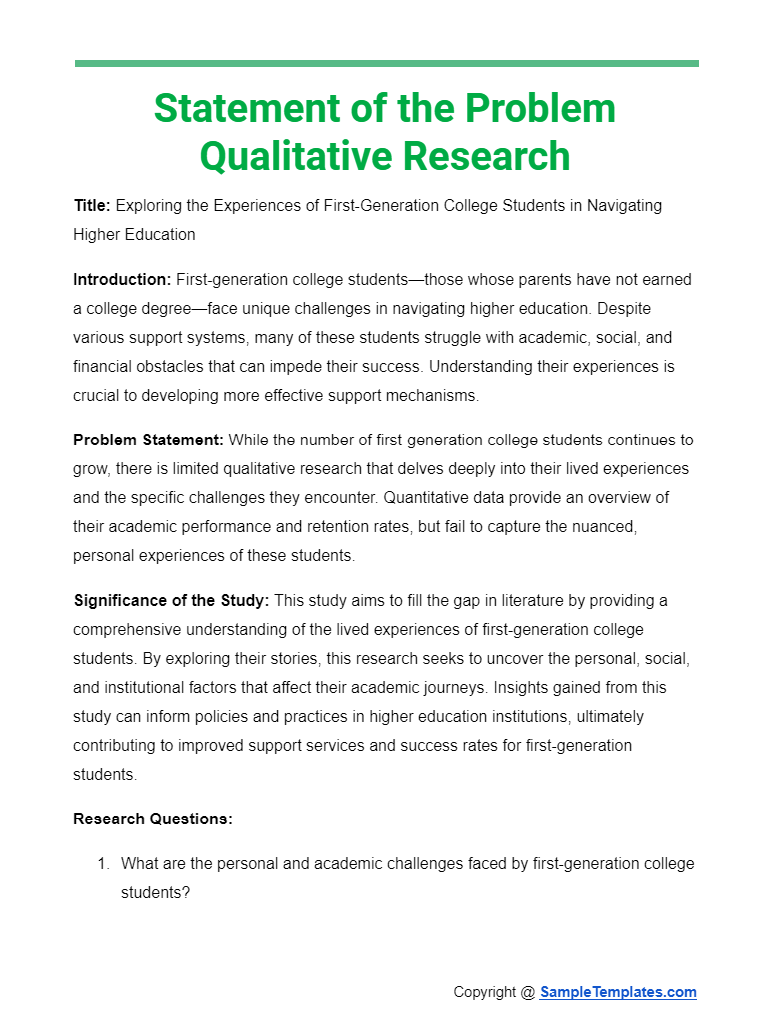
Research Problem Statement Examples
Title: Understanding the Impact of Remote Work on Employee Work-Life Balance During the COVID-19 Pandemic
Problem Statement: The COVID-19 pandemic has forced many organizations to rapidly adopt remote work practices. While this shift has been necessary to ensure public health and safety, it has also introduced significant changes to the traditional work environment. The sudden transition to remote work has blurred the boundaries between work and personal life, potentially affecting employees’ work-life balance. Despite the growing body of quantitative research on remote work productivity and efficiency, there is a significant lack of qualitative understanding of how remote work impacts employees’ work-life balance from their own perspectives.
Background: Prior to the pandemic, remote work was often seen as a flexible option that could enhance work-life balance by reducing commute times and offering more control over work schedules. However, the abrupt and widespread shift to remote work during the pandemic has created a unique situation where employees, often with little preparation or support, have had to manage their professional responsibilities alongside personal and familial obligations within the same physical space. This scenario has created a complex interplay of factors that influence work-life balance in ways that are not yet fully understood.
Significance of the Study: Understanding the impact of remote work on work-life balance is crucial for developing effective workplace policies and practices. Insights gained from this study can help organizations design better support systems that promote employee well-being, productivity, and job satisfaction. By exploring the lived experiences of employees, this research aims to provide a comprehensive understanding of the challenges and benefits of remote work, ultimately contributing to the development of more balanced and sustainable remote work practices.
Research Questions:
- How do employees perceive the impact of remote work on their work-life balance during the COVID-19 pandemic?
- What are the key challenges employees face in maintaining work-life balance while working remotely?
- What strategies do employees use to manage work-life balance in a remote work setting?
- How do organizational policies and support systems influence employees’ work-life balance during remote work?
Conclusion: By addressing these research questions, the study aims to provide valuable insights into the experiences of employees working remotely during the pandemic. The findings can inform organizational leaders, human resource professionals, and policymakers in creating and implementing strategies that support a healthy work-life balance for remote employees, both during the current pandemic and in future remote work scenarios.
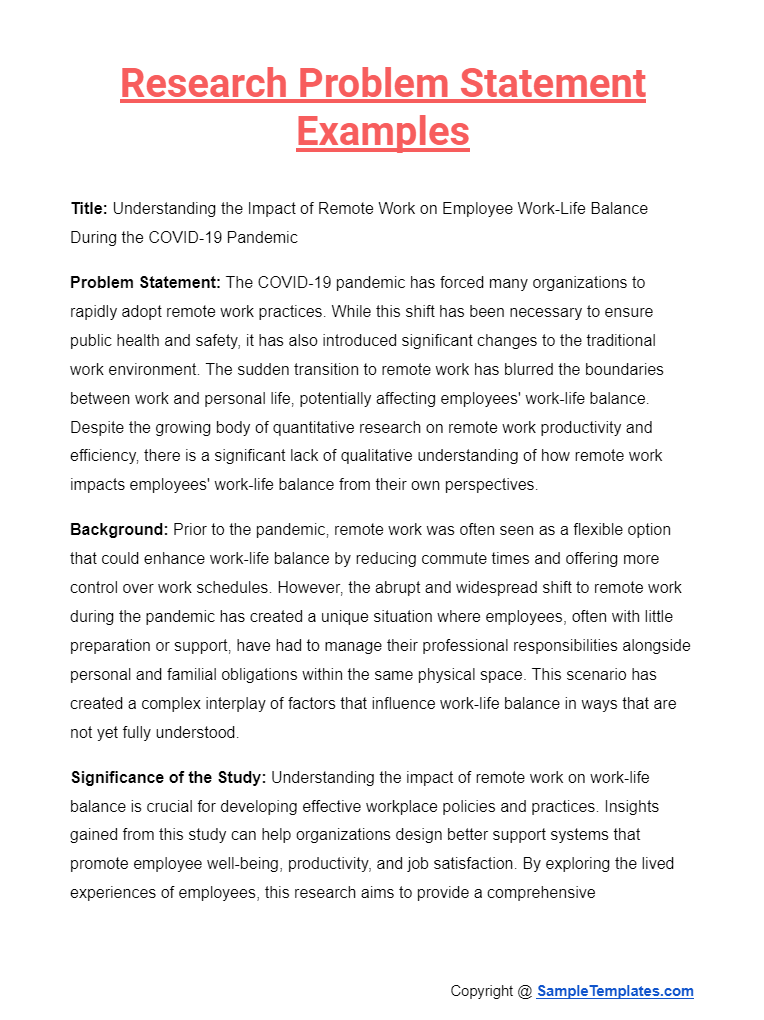
PHD Research Proposal Problem Statement
Title: Investigating the Role of Artificial Intelligence in Enhancing Personalized Learning in Higher Education
Problem Statement:
Introduction: The rapid advancements in Artificial Intelligence (AI) have transformed various sectors, including education. In higher education, there is a growing interest in leveraging AI to enhance personalized learning, where educational experiences are tailored to individual students’ needs, preferences, and learning styles. Despite the potential benefits, the integration of AI in personalized learning presents numerous challenges and uncertainties.
Background: Personalized learning has been recognized as an effective approach to improve student engagement, motivation, and academic outcomes. Traditional methods of personalized learning rely heavily on human intervention, which can be time-consuming and limited in scalability. AI has the potential to address these limitations by providing real-time, data-driven insights and adaptive learning pathways for students. However, the implementation of AI in personalized learning is still in its infancy, and there is limited understanding of its impact on educational outcomes, student satisfaction, and the teaching-learning process.
Significance of the Study: Understanding the role of AI in enhancing personalized learning is crucial for several reasons. Firstly, it can provide insights into how AI-driven personalized learning can be effectively implemented in higher education institutions. Secondly, it can help identify the potential benefits and drawbacks of using AI for personalized learning from the perspectives of students, educators, and administrators. Finally, it can contribute to the development of best practices and guidelines for integrating AI in educational settings, ensuring that the technology is used ethically and effectively to enhance learning experiences.
Research Gap: While there are studies on the potential of AI in education, there is a significant gap in empirical research that explores the practical implementation and impact of AI-driven personalized learning in higher education. Most existing studies are theoretical or focus on specific AI technologies without examining their holistic impact on the learning ecosystem. This study aims to fill this gap by providing a comprehensive analysis of how AI can enhance personalized learning, considering various stakeholders’ perspectives and experiences.
Research Questions:
- How do higher education institutions currently implement AI-driven personalized learning, and what challenges do they face?
- What are the perceptions and experiences of students and educators regarding AI-driven personalized learning?
- What impact does AI-driven personalized learning have on student engagement, motivation, and academic performance?
- What ethical considerations and best practices should be taken into account when implementing AI in personalized learning?
Conclusion: This research aims to provide a detailed understanding of the role of AI in enhancing personalized learning in higher education. By exploring the implementation processes, stakeholder experiences, and educational outcomes, the study will offer valuable insights into the practical and ethical implications of using AI in personalized learning. The findings will contribute to the development of effective strategies and policies for integrating AI in higher education, ultimately improving the quality and accessibility of personalized learning experiences.
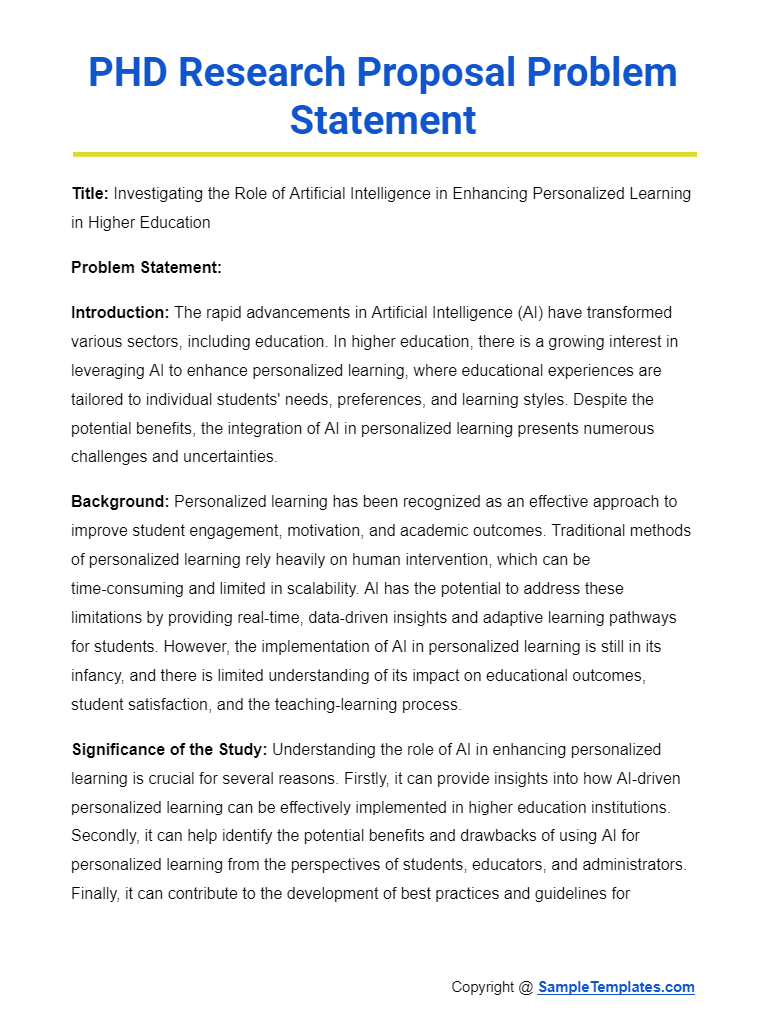
Statement of the Problem Example
Title: The Impact of Social Media on Adolescent Mental Health
Statement of the Problem:
Introduction: In the digital age, social media platforms such as Facebook, Instagram, Twitter, and TikTok have become integral parts of adolescents’ lives. While these platforms offer opportunities for socialization, self-expression, and information sharing, there is growing concern about their impact on adolescent mental health. This study aims to investigate the relationship between social media use and mental health outcomes among adolescents.
Problem Statement: Despite the widespread use of social media among adolescents, there is a lack of comprehensive understanding of its effects on their mental health. Existing studies provide mixed results, with some indicating negative impacts such as increased anxiety, depression, and low self-esteem, while others suggest potential benefits like social support and enhanced communication skills. The conflicting findings highlight the need for a deeper exploration of how different aspects of social media use—such as time spent, types of engagement, and content exposure—affect adolescent mental health.
Background: Adolescence is a critical developmental period characterized by significant physical, emotional, and social changes. During this time, individuals are particularly vulnerable to external influences, including those from social media. With the rapid increase in social media usage, concerns have been raised about its potential to exacerbate mental health issues among adolescents. Understanding the specific ways in which social media impacts mental health is essential for developing effective interventions and support systems.
Significance of the Study: This study is significant because it addresses a pressing public health issue. By providing a nuanced understanding of the relationship between social media use and adolescent mental health, the research can inform educators, parents, policymakers, and mental health professionals. The insights gained can guide the development of targeted strategies to mitigate the negative impacts of social media while promoting its positive aspects. Ultimately, the findings can contribute to healthier digital environments for adolescents.
Research Questions:
- How does the amount of time spent on social media correlate with mental health outcomes such as anxiety, depression, and self-esteem among adolescents?
- What types of social media engagement (e.g., passive scrolling, active posting, interactions) are associated with positive or negative mental health outcomes?
- How does exposure to different types of content (e.g., positive vs. negative, supportive vs. harmful) on social media affect adolescents’ mental health?
- What role do demographic factors (e.g., age, gender, socio-economic status) play in moderating the relationship between social media use and mental health?
Conclusion: By exploring these research questions, the study aims to provide a comprehensive understanding of the complex relationship between social media use and adolescent mental health. The findings will offer valuable insights for stakeholders involved in adolescent development and mental health, enabling them to create supportive environments that harness the benefits of social media while minimizing its potential harms.
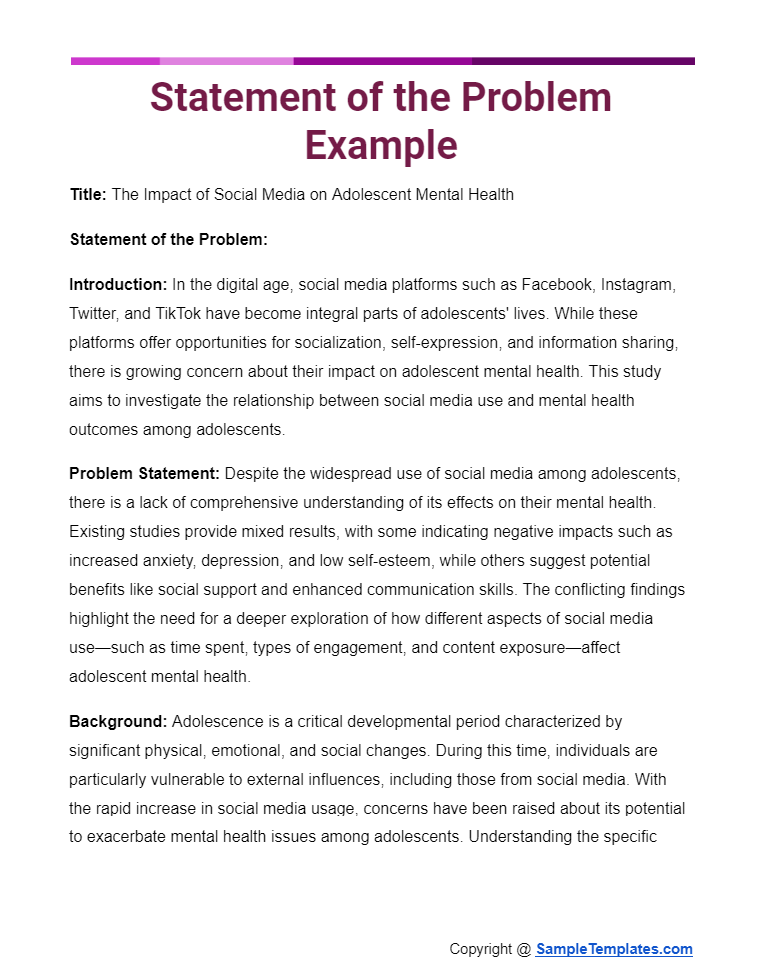
Browse More Templates On Research Proposal Problem Statement
1. Research Proposal Problem Statement Template
2. Sample Research Project Proposal Problem Statement Template
3. Research Group Proposal Problem Statement Template
How to Make a Research Proposal Problem Statement
A problem statement is a concise description of the problem(s), and it contains a vision, issue statement, and solution technique. The goal of the research study you will propose should be clearly identified by writing a sample statement of the problem. Aside from the variety of our free templates of Research Problem Statements that is provided above, you can also make one of your own from scratch. If you’re interested in making a problem statement specific to your research paper, here are some general tips you could consider to guide you:
1. The ideal/vision
This answers the question “What does the world look like if the problem is solved?” Describes an ideal state or a desired aim; explains how things should be.
2. The relevance of your research topic
You demonstrate the relevance of your study by emphasizing the importance of the subject under inquiry. This does not, however, imply that you will discover something remarkable or unimaginable.
The goal is to clearly express how and why your research problem is a relevant issue in your chosen field of study and why further research is needed.
3. Defining the Goals and Objectives
The purpose of a problem statement is to give a framework for solving the problem. A good issue statement of purpose does not provide a specific solution to any problem; instead, it focuses on how to effectively understand or solve a problem by identifying the problem’s underlying causes. After all, the end goal or general purpose of a research project is its goal.
4. Current State and Evidence
Describe the current state of the issue, presenting existing data, statistics, or studies that highlight the prevalence or severity of the problem. Contextualize the issue within a real-world setting and provide concrete evidence to support the relevance of your research.
5. Implications and Consequences
Discuss the potential implications and consequences if the problem is not addressed. Highlight the possible negative outcomes for individuals, communities, industries, or broader societal impacts. Convey the urgency of the research by emphasizing the critical nature of solving the problem.
4. Basic Research Proposal Statement of Problem Template
5. Research Work Proposal Problem Statement Template
6. Problem Statement of Research Proposal Template
How to Start a Problem Statement?

Starting a problem statement involves clearly defining the issue you intend to address. Here are some steps to help you create an effective problem statement:
1. Understand the Problem:
- Research: Gather as much information as possible about the issue.
- Identify the Root Cause: Determine the underlying problem, not just the symptoms.
2. Define the Problem Clearly:
- Concise Description: Start with a brief and clear description of the problem.
- Specific Details: Include specific details such as the context, affected parties, and the impact of the problem.
3. Explain the Significance:
- Impact: Describe why this problem is important to solve.
- Consequences: Explain the potential consequences if the problem is not addressed.
4. Scope of the Problem:
- Boundaries: Define the boundaries of the problem (what is included and what is not).
- Affected Areas: Specify the areas affected by the problem.
5. Objectives:
- Goals: Outline the objectives you aim to achieve by solving the problem.
- Desired Outcomes: Describe the desired outcomes and benefits of solving the problem. You can also see more on business research problem statement.
7. Basic Action Research Proposal Problem Statement Template
8. Research Thesis Proposal Problem Statement Template
9. Quantitative Research Proposal Problem Statement Template
Important Features of Research Problem Statement
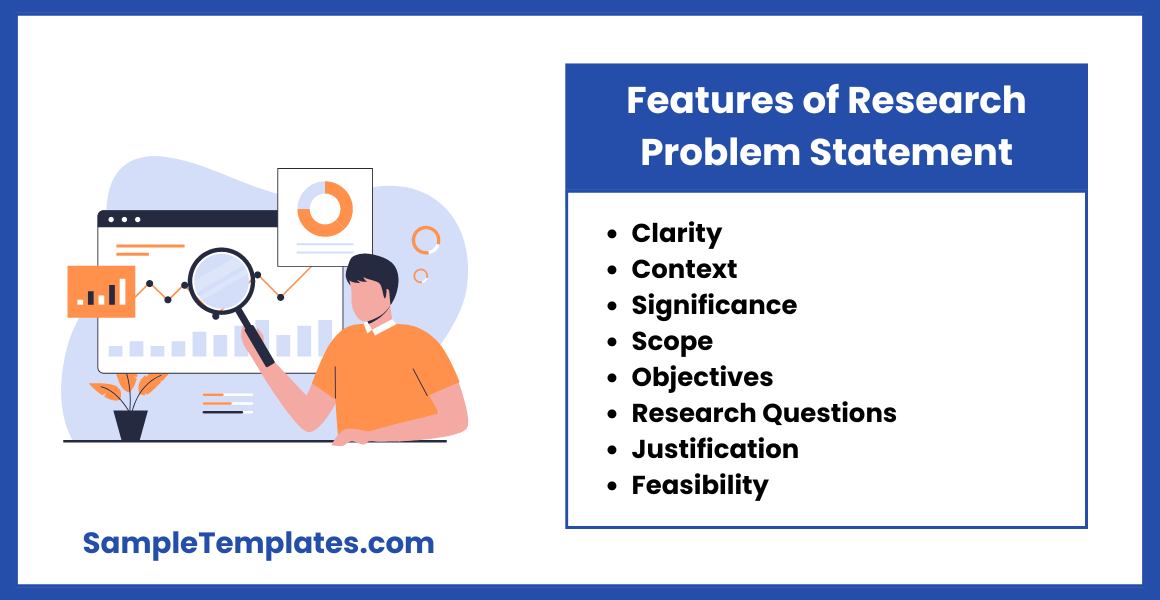
An effective research problem statement should include several key features to ensure clarity, relevance, and focus. Here are the important features:
1. Clarity:
- Clear and Concise: The problem statement should be clearly written, avoiding jargon and overly complex language.
- Specificity: It should specify the issue in detail, leaving no room for ambiguity.
2. Context:
- Background Information: Provide enough background information to understand the context of the problem.
- Relevance: Explain why the problem is relevant in the current context or field of study.
3. Significance:
- Importance: Highlight the importance of the problem and its impact on the field, industry, or society.
- Consequences: Describe the potential consequences if the problem is not addressed.
4. Scope:
- Boundaries: Define the scope of the problem, including what is and isn’t included in the study.
- Focus: Maintain a clear focus on the main issue without diverging into related but separate problems.
5. Objectives:
- Research Goals: Outline the primary objectives of the research, including what you aim to discover or solve.
- Desired Outcomes: Describe the desired outcomes or benefits of addressing the problem.
6. Research Questions:
- Guiding Questions: Include specific research questions that guide the investigation and help to focus the study.
7. Justification:
- Rationale: Provide a rationale for why this problem was chosen and its relevance to the field.
- Evidence: Use evidence or data to support the existence and importance of the problem.
8. Feasibility:
- Practicality: Ensure that the problem can be realistically addressed within the constraints of your resources, time, and capabilities. You can see more on Report Problem Statement.
10. Sample Research Proposal Literature Problem Statement Template
11. Research Proposal Problem Statement Template
What Is the Research Proposal Problem Statement?
Identifying and delineating the research problem statement: that is, what the researcher wants to solve and what questions he or she wants to answer is the first and most crucial phase in any research. A research problem can be defined as a source of concern, a knowledge gap, or a variation from the norm or standard that necessitates further inquiry and investigation. A problem statement is a clear, concise description of the issue(s) that a research writer must address. It is used to concentrate and center the researcher(s) at the start of the effort, to keep the researcher(s) on track during the effort, and to validate that the effort produced an output that solves the issue statement. The ultimate purpose of a sample statement of the problem is to reduce a broad problem to a specific, well-defined issue that can be solved by rigorous investigation and decision-making.
FAQs
What is the ideal length for a research problem statement?
It should be no more than one or two sentences in length. It should not offer a suggestion for a solution.
What characteristics distinguish an excellent problem statement?
A problem statement should express an unfavorable difference in performance review between the existing state and the intended future state. A problem description should include absolute or relative problem measures that quantify the gap, but not probable causes or solutions.
What exactly does a research proposal entail?
Your research technique should be presented in the proposal sample, with particular examples to demonstrate how you will perform your research. Visits to certain libraries or archives, field work, or interviews could all be part of your strategy.
All in all, the problem statement of a sample research proposal is important as it eliminates the knowledge gap. It must be substantial in the sense that it contributes to the research in a good way and contribute to future research. Download our free, editable, and printable samples of Research Proposal Problem Statements in order to help you out with this!
Related Posts
FREE 10+ Medical Problem Statement Samples [ Surgical, Nursing, Management ]
FREE 10+ Payoff Statement Samples in PDF | DOC
FREE 10+ Scholarship Statement of Purpose Samples in PDF | DOC
FREE 10+ Engineering Problem Statement Samples [ Software, Mechanical, Civil ]
FREE 30+ Information Statement Samples in PDF | MS Word
FREE 50+ Policy Statement Samples in MS Word | Google Docs | PDF
FREE 50+ Summary Statement Samples in PDF | MS Word
FREE 10+ Nursing School Personal Statement in PDF
FREE 9+ Mortgage Statement Samples and Templates in PDF
FREE 10+ Independent Subcontractor Statement Samples in MS Word | Google Docs | Apple Pages | PDF
FREE 10+ Trust Distribution Statement Samples in PDF
FREE 14+ Compliance Statement Samples & Templates in PDF | MS Word
FREE 10+ Extension Impact Statement Samples in PDF | DOC
FREE 10+ Bank Reconciliation Statement Samples and Templates in PDF | MS Word
FREE 10+ Diversity Mission Statement Samples in MS Word | PDF
